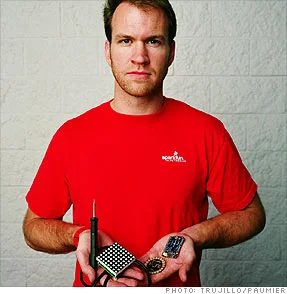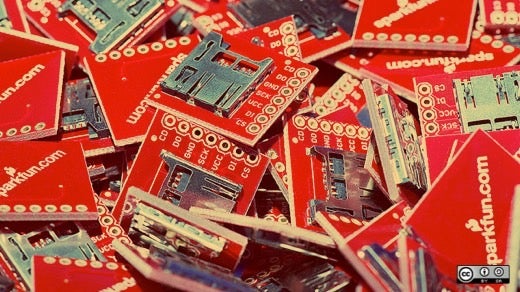 SparkFun Electronics was founded in 2003 as a source for engineers, inventors, prototypers and DIY enthusiasts to find the gear and tools they need to make their electronics projects possible. More than a decade later, SparkFun is still a leader in the world of open source hardware.
SparkFun Electronics was founded in 2003 as a source for engineers, inventors, prototypers and DIY enthusiasts to find the gear and tools they need to make their electronics projects possible. More than a decade later, SparkFun is still a leader in the world of open source hardware.
In this interview, I sat down with founder and CEO Nathan Seidle to talk a bit about what drives SparkFun’s open source hardware model.

Can you tell us a little bit about SparkFun’s relationship with the open source world and what it means to SparkFun?
The majority of the in-house designed products are open source. I’m going to estimate that’s somewhere around 400-450 different products that are designed in Niwot that are open source hardware and follow the open source hardware definition. Some of the code base that runs our website is also open source, but that’s more limited for various security reasons.
To be in-line with the open source definition as it relates to hardware, you have to post editable source files and you cannot have the "-NC" limitation (which means “non-commerical use”). “-NC” does not equal open source, so if you say: "Oh, you can use this for whatever you want, except you can’t sell it!"—that is not open source hardware. You can’t limit what the design can be used for. There are some other rules in the open source hardware definition that we follow, but those are two big ones.
As it relates to SparkFun, the open source model is really a business model. It’s the way we run our business.
What are the benefits of being an open source hardware company?
Over time, we’ve seen our competitors come out with similar products—that’s fine, that’s going to happen in commerce. But as a result, one of the main benefits is that has forced us to design all of our systems to be really flexible. For example, in quality control, they are figuring out how to design test procedures and test jigs very quickly so we can come out with a new revision, and we have a test procedure in place to support that.
It also challenges us to create outstanding products and support around those products. People might find something on Amazon that they can also get on SparkFun—why buy from us? Well, we give you sample code, we have great hook-up guides, we have a phone number where you can call us, and we offer outstanding customer service and tech support. We have a great video of the product in action! We’ve heard from more and more customers that are buying from us because they know that when they buy these five things to build their prototype, they are open source hardware and they have access to the source files—so they are immediately a step ahead. They don’t have to start from scratch.
SparkFun carries many products that are not open source hardware—how do you find the balance between being an open source company and carrying the best gear?
Let’s take an example. We’ll talk to a potential new supplier and we say: "Hey, that’s a really cool wireless module!" As soon as the supplier starts saying, "OK, well you gotta sign a NDA, and you can’t release this document, and this is closed and that is closed,” those are all red flags and we’re less and less likely to work with that supplier. But, with that said, just being proprietary is not a red flag. We respect that. If you want to keep the firmware as a binary blob, if you wanted to keep it locked up—OK. That’s fine. We can respect that. We try to work with folks to bring the best products possible to our customers.
What advice would you give to someone starting a company with a open source hardware model?
The one I always tell folks is: "just get it posted." The thing that you’re designing is never going to be" finished." Don’t get caught in the engineer’s trap of feature creep. Just put a “buy it now" button next to it and be very descriptive about what it does and doesn’t do. The Internet is a really big place—I guarantee someone will buy it! At SparkFun, whenever we list stuff with green wires (which we don’t do much anymore), but back in the day it was like, “Hey, here is this thing! It’s got a green wire on it, so don’t be surprised.” As long as you set the level of expectation for what you are getting, the customer will make the choice. Give them the ability to do that and you might be surprised.
SparkFun was ultimately successful because we didn’t launch one product, we launched a lot of products. So if you’re thinking about starting your own company, don’t put all your eggs in one basket. Come out with a couple different products and see how they sell, see what the market is looking for and be prepared to expand from there.
Don’t set the price so low that you can’t eat. It’s easy to want to price things as low as possible, but you need to account for a lot of things you might forget about, most notably your time. You need to build in enough margin that pays for your time to design and build the thing. It doesn’t have to be a lot, but make sure to build that in there.
You can learn more about SparkFun at SparkFun.com.
Hardware
Connection
This article is part of the Open Hardware Connection column coordinated by Jason Hibbets. Share your stories about the growing open hardware community and the fantastic projects coming from makers and tinkers around the world by contacting us at open@opensource.com.






Comments are closed.